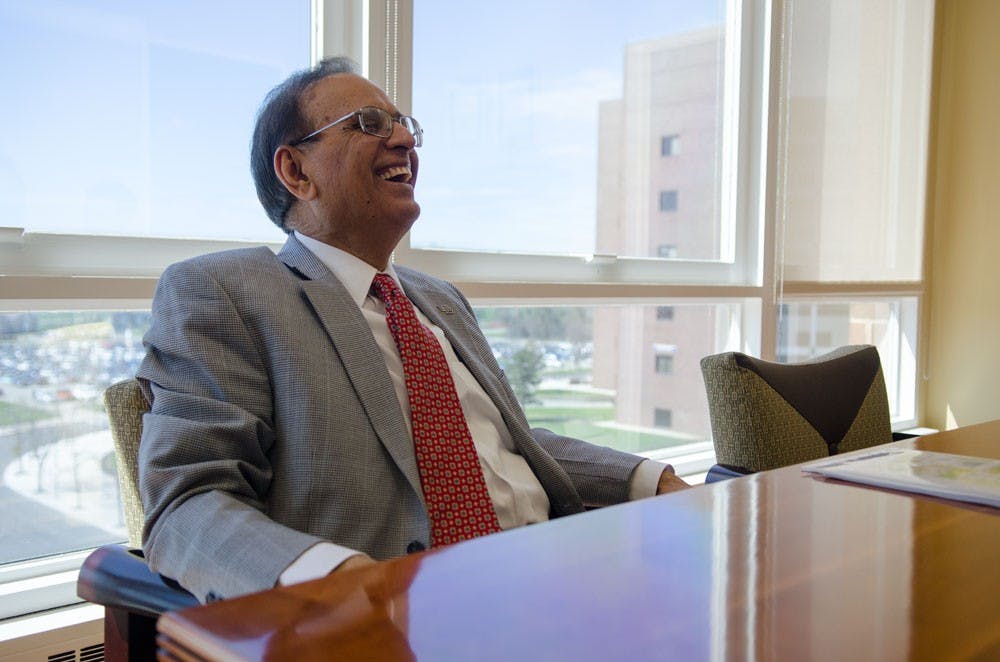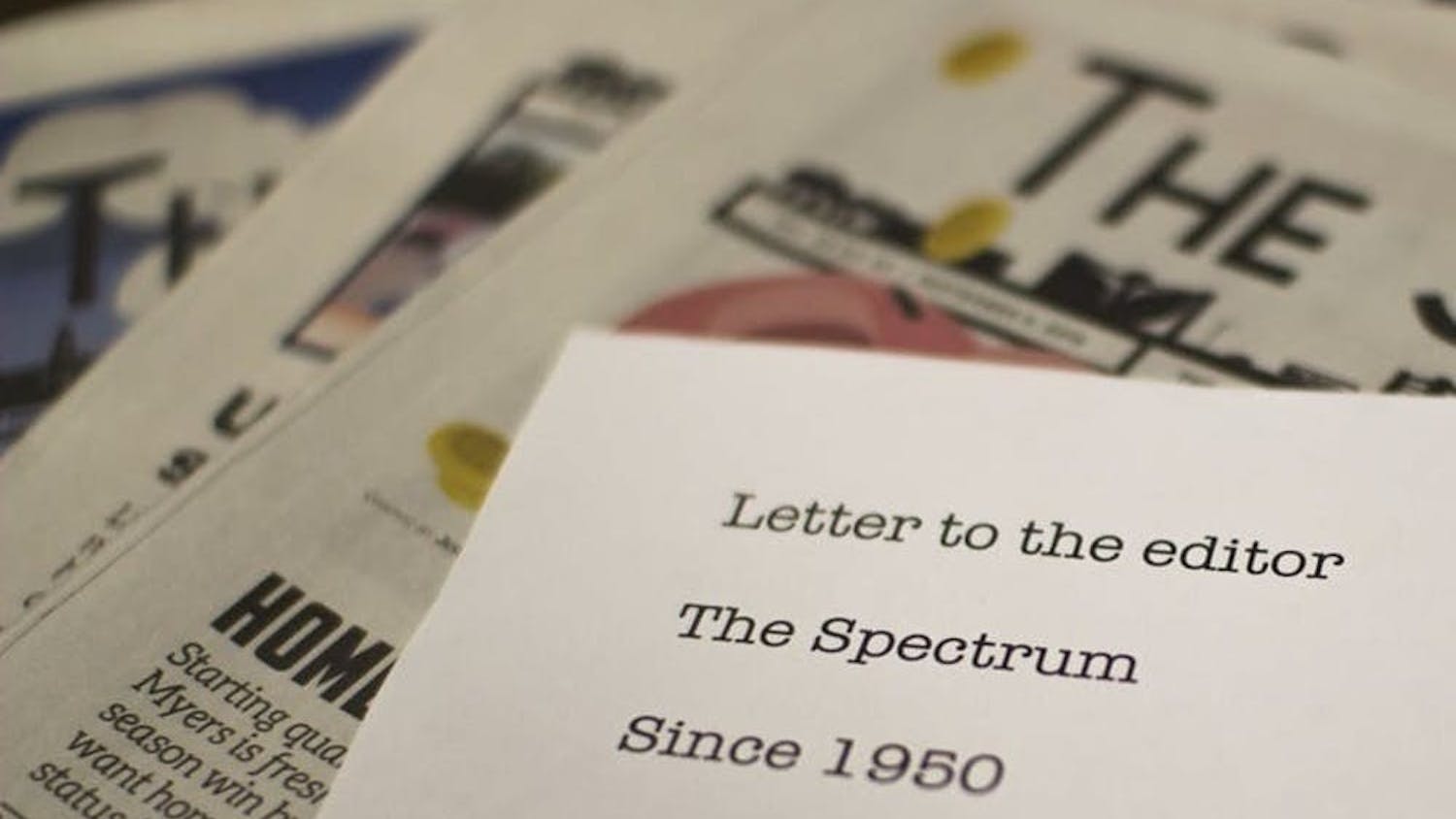On a sunny Friday morning, President Satish Tripathi has the black and red robe he wears for commencement ceremonies laid out on a chair in his office on the top floor of Capen Hall.
It’s for the School of Medicine graduation – the first time of at least ninehe’ll don the garb this month, as the 2014-15 academic year ends.
“This is the time of the year there is so much excitement and you can see the achievements of the students and you can see them succeeding,” he said.
As this year wraps up and students prep to shake Tripathi’s hand as the hallmark end to their college education, he sat down with The Spectrum to talk about some of the biggest topics on campus. From the future of South Campus to the athletics department and how he views his own presence and relationship with students on campus, Tripathi spoke candidly to Spectrum Editor in Chief Sara DiNatale. It was the first time he has sat down with The Spectrum since 2012, but he said last week he would meet with The Spectrum annually.
Tripathi became the president of the university in 2011, after serving as UB’s provost and executive vice president for Academic Affairs starting in 2004.
He said since he’s come to campus it’s been his goal for students to “improve the quality of experiences students have.” He said he’s worked to ensure UB’s Academies, an on-campus community that connects students with similar interests, make UB’s massive campus seem smaller. He said he’s strived to give undergrads, not just graduate students, opportunities to work with professors on research. He’s also proud of UB’s new general education requirements – which he said focuses more on themes like social justice and entrepreneurship and less on checking off requirements.
“It took almost a year but we have one of the best, forward-looking gen ed programs,” Tripathi said.
But what Tripathi sees as one of his biggest – and yet to be completed goals – is to “revitalize” South Campus.
In 2017, UB’s medical school is moving downtown, leaving some to question: What’s going to happen to South Campus and the troubled University Heights district?
Tripathi said the now North Campus-based School of Social Work and Graduate School of Education will move to South. But Tripathi said that won’t happen without improvements to infrastructure to the South Campus buildings. Tripathi said UB would also be getting rid of the campus’ “temporary” buildings – though not meant to stand for long, structures like the Acheson Annex were erected in 1965 and are still used today.
Tripathi said he envisions the campus being restored to its “E.B. Green days" – an homage to the architect who drew up South’s original campus plan. Tripathi said Hayes Hall is undergoing $50 million in renovations, which will be done in about a year.
Most of the buildings on South Campus are old and need work – but so does the surrounding area.
In 2012, there were 523 crimes in the University Heights district where a large number of UB students live, including 272 larcenies and 118 burglaries.
A Spectrum poll in 2013 showed that out of 787 students polled, 428 did not feel safe in the Heights. Of 760 students polled, The Spectrum found that 82 percent of students felt UB needed to do more to improve living conditions for students in the Heights.
Tripathi said he feels the campus is taking an “active role” in the Heights. He said he’s meet with Common Council member of the area Rasheed Wyatt and said he plans to meet with him again. He also mentioned UB bought security cameras for the city and that continuation of “housing blitzes,” in which Off-Campus Student Services coordinates inspections of South Campus homes, as things UB has done to assist the Heights.
“The city doesn’t have enough people to inspect the houses because unless you get inspected and get cited, it’s hard for actions to be taken, so we’ve worked on that as well,” Tripathi said.
UB reimburses the city for the inspector’s overtime because the blitzes usually happen on weekends.
Alums, he added, remember South “being where the campus ‘was,’” and he said he wants to bring that back – though he admits it will be a long and slow process.
Tripathi said UB will need to work with the city’s stakeholders and the area’s the real estate developers to “make sure we really restore that area.”
Tripathi – though clearly a busy UB president – says he feels like he has a strong presence on campus and among students. Some students say they’ve never seen Tripathi, but Tripathi said that can come down to perceptions.
“Perceptions are important but they’re just perceptions,” Tripathi said. “I’m on the campus, multiple events every week, where there are some students there. I’m in the Commons, in the Student Union building having lunch … But I’m meeting with student groups all the time actually, and I think it’s important for me to talk to students to find out what their concerns are.”
He said he’ll be at the senior brunch Friday and has already attended a series of luncheons and student award ceremonies.
He said he’s proud of UB’s athletic teams who for the first time ever had three separate teams get NCAA Tournament berths in one year. Tripathi described himself as a “cheerleader” for the program, adding he hopes Athletic Director Danny White is successful in fundraising enough money to build a field house on North Campus.
“I’m not into hiring coaches or getting games, but as a president, I’m supportive of the Athletics, I think its important experience for the students – not only for the student-athletes but the whole student body here,” Tripathi said.
Tripathi mentioned the UB Foundation will be unrolling a new website this month to foster transparency, which the private foundation that handles UB’s nearly $1 billion in donations is accused by some faculty for not having. He said the separation between the UBF as a private entity and UB as a public one is important.
“It has the donors money and the donors will not give money if they believe it is going to be part of the state fund because a lot of the donor money is forever, to create an endowment that really is forever so [UBF] really believe[s] in that kind of separation,” Tripathi said.
But Tripathi mainly focused the interview on his main goals for his tenure, which includes ensuring students during their time at UB. Whether they’re interacting in a global community or with UB’s international students, Tripathi said the campus offers students an environment to grow.
His biggest piece of advice for the graduating class?
Take risks – because you don’t know when “pushing the boundaries” will lead to the next big invention or breakthrough.
“You studied here, you got your education but don’t be afraid to take risks,” he said.
Update: A previous version of this article mistakenly referred to E. B. Green as E. B. White.
Sara DiNatale is the editor in chief and can be reached at sara.dinatale@ubspectrum.com.





